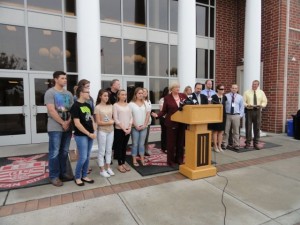Student scientists explaining their space experiment at a news conference Wednesday include (from left) Dan Loggi, Lauren Bowersock, Alison Miles, Kaitland Wriggins, Mercy Griffith and Kristina Redmond.
(The video footage above was filmed by Ocean City High School student Matt Unsworth for the school TV station and news site OC-TV/Current OC.)
Ocean City High School senior Mercy Griffith listened to the cheers at liftoff and felt "so, so excited" as she watched an unmanned rocket leave the ground early Tuesday evening carrying a science experiment designed by her and five classmates.
But Lauren Bowersock, Kristina Redmond, Daniel Loggi, Kaitland Wriggins, Alison Miles and she then saw a bright flash of fire as the rocket exploded shortly after takeoff on Wallops Island on Virginia's Eastern Shore.
Griffith said they heard a loud boom that resonated across the water to the safe viewing area where they watched the launch. Uncertain at first exactly what was happening, the students stood paralyzed and in shock, and they all cried when they came to the quick realization of what had happened, she said.
Griffith shared her first-hand account during a news conference Wednesday morning at Ocean City High School, where the students, teachers and school administrators involved in the project gathered to share information on the catastrophe and reflect on lessons learned from it.

Students, teachers and administrators involved in the Student Spaceflight Experiments Program (SSEP), including Superintendent Kathleen Taylor (at podium) and Board of Education President Joe Clark (to her left), talk about the rocket that exploded Tuesday in Virginia.
Nobody was injured in the
explosion of the rocket launched by the private Orbital Sciences Corporation.
"First, we want to say that we are thankful no one was hurt in this accident," Superintendent Kathleen Taylor said in a prepared statement. "Our students and staff were in a safe secure location to view the launch."
The
OCHS experiment is part of the Student Spaceflight Experiment Program (SSEP), a national program designed to inspire a new generation of scientists and engineers in the U.S. The Ocean City students competed against others nationwide for the opportunity to have their experiment conducted aboard the International Space Station.
The Ocean City experiment analyzes the effect of microgravity on the attachment rate of E. coli bacteria to lettuce cells — information that would be practical if people ever tried to cultivate food during long periods of travel in space, according to Bowersock.
"Our students are learning that the world of science is full of twists and turns — the line between success and disappointment can sometimes be blurred," Taylor said. "We recall the words of another great New Jersey scientist, Thomas Edison, 'Our greatest weakness lies in giving up. The most certain way to succeed is always to try just one more time.' "
Science teacher Dan Weaver said multiple "ferries" are going up to the International Space Station in the next several months, and the SSEP could find space on one for the student experiments.
"Making the experiment again is going to be pretty easy for us," Bowersock said. "We were not saddened so much about our experiment as were for all the people who worked on the rocket."
The students had a chance to meet with engineers, a former astronaut, scientists and other student science teams during their trip to Virginia.
"You can be sure that we in Ocean City are determined to succeed," Taylor said. "We will use this moment to spur us on to greater and better things. We are going to try not just one more time, but many more times."
